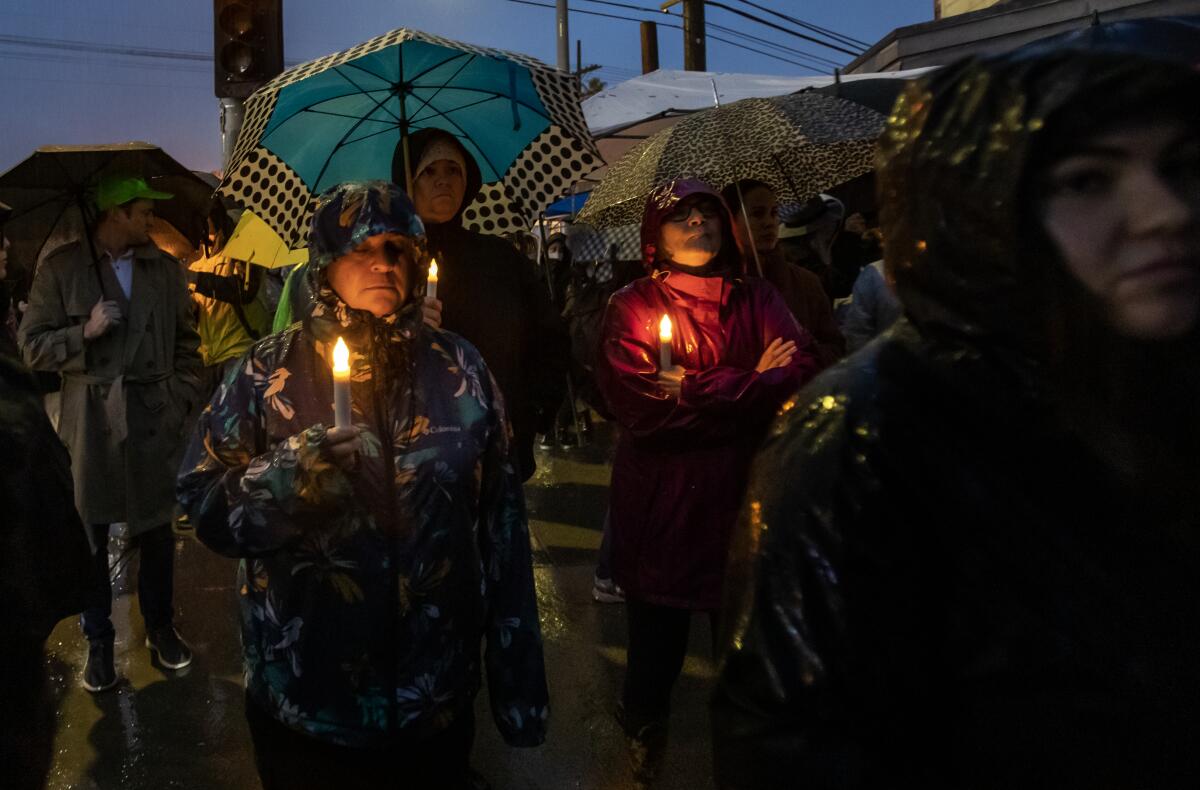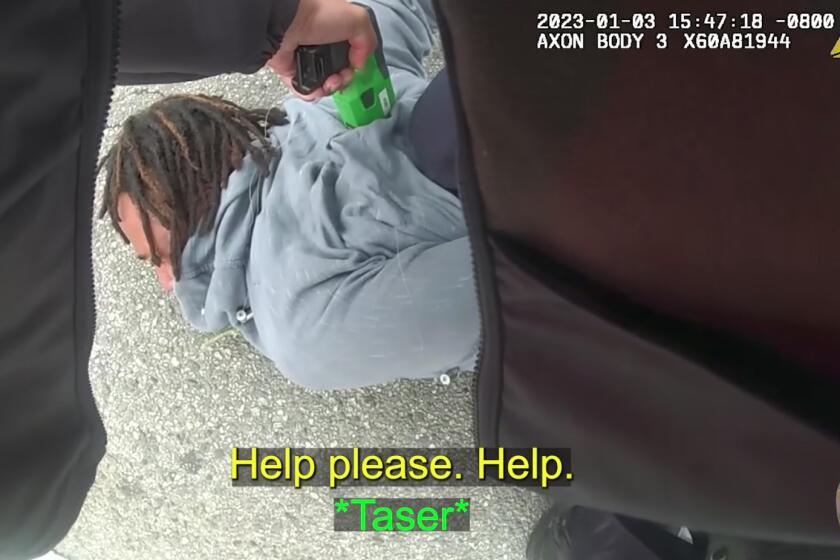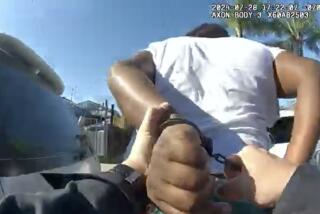LAPD officers tased Keenan Anderson 6 times in 42 seconds

- Share via
For a disturbing 42 seconds, a Los Angeles police officer repeatedly stunned a teacher with a Taser gun this month as other officers tried to pin and handcuff the man in the middle of a busy Venice street.
The gaps between pulses were so brief that Keenan Anderson, 31, could get out only a few words — including “Help me, please” — as he repeatedly cried out in agony.
Anderson died several hours later, though his cause of death has not yet been established.
The actions of the officers, captured on LAPD body cameras, have sparked protests, an internal investigation and calls for changes in police policies.
In particular, the case has placed scrutiny on Los Angeles Police Department guidelines on officers’ use of Tasers. Its written policies address the circumstance under which Tasers can be used but are vague when it comes to how often the weapon should be fired.
LAPD policy states that officers “may use the Taser as a reasonable force option to control a suspect when the suspect poses an immediate threat to the safety of the officer or others.”
Videos released this week of a teacher who died after Los Angeles police discharged a Taser on him at least six times on a Venice street raise serious concerns about the officers’ tactics, law enforcement experts who reviewed the tapes said.
There is already much debate about whether Anderson posed the kind of threat to officers that six Taser discharges were necessary, with several policing experts saying it was not.
“Just because he is actively resisting, that doesn’t mean he is a threat,” said Seth Stoughton, a University of South Carolina law professor and use-of-force expert who reviewed the LAPD body-cam videos.

“He is not a threat of harm to the officers. The only threat is a delay,” said Stoughton, a former Florida police officer. “It doesn’t appear to me the officers believe the Taser protects them from harm.”
LAPD policy attempts to address this distinction, saying Tasers “shall not be used on a suspect or subject who is passively resisting or merely failing to comply with commands.” Not responding to verbal commands, the policy states, is not grounds for using a Taser.
Videos released this week of a teacher who died after Los Angeles police discharged a Taser on him at least six times on a Venice street raise serious concerns about the officers’ tactics, law enforcement experts who reviewed the tapes said.
Another major question for use-of-force experts concerns the number of times Anderson was tased.
LAPD policy does not address how frequently an officer can use a Taser on a suspect and what to do if the first discharge does not resolve an incident. A 2021 directive urged officers to “avoid repeated Taser applications where practicable to avoid possible injury.”
The directive also instructed officers to “continually evaluate the situation they are in and the apparent effectiveness” and, if Taser use isn’t working, to “consider transitioning to another” tactic.
According to LAPD policy, the duration of a Taser activation on a suspect is five seconds. “During this period of incapacitation that the suspect/subject experiences, the arrest team should take positions of advantage to immediately control the suspect/subject and take them into custody.”
In releasing a video of the tasing of Anderson compiled from officers’ body cameras, Chief Michel Moore said that there is no limit on the number of times a Taser can be used in a particular situation and that the actions must be reasonable given the totality of the circumstances.
Some policing experts said the current rules give much latitude — perhaps too much — to officers.
Ed Obayashi, a Northern California deputy, police lawyer and use-of-force expert who reviewed the LAPD’s body-cam footage, said the department is among many that have not set limits on how often Tasers are used.

The most problematic repeated uses occur when a person falls into a specific risk category, such as those who are on drugs. Moore has alleged that Anderson was in an altered state and resisted officers’ efforts to detain him. His bloodwork showed the presence of cocaine and cannabis in his system, the chief said.
In the wake of Anderson’s death, some community activists have called for new limits on Taser use by officers.
Stoughton said the six uses of the Taser on Anderson are a significant issue. “The more you use it, the higher the risk,” he said. The stun gun, he said, was initially conceived as a replacement for deadly force and a response to edge and blunt weapons. “The term ‘lazy tasy’ has become common. It is as easy as snapping a photo.”
A dozen years ago, the Police Executive Research Forum advised law enforcement agencies that people should not be exposed to an electronic control weapon, such as a Taser-branded stun gun, for more than 15 seconds total. “Personnel should be trained to use an ECW for one standard cycle (five seconds) and then evaluate the situation to determine if subsequent cycles are necessary,” the guidelines stated.
LAPD Chief Michel Moore addressed the three deaths at Tuesday’s meeting of the Police Commission, promising to make public body-camera footage the following day.
Some departments have, however, offered more specific rules.
In Eugene, Ore., the “number of Taser discharges against a person should not exceed three, or a total duration of 15 seconds.” Eugene police officers are cautioned that “multiple Taser discharges or discharges exceeding the standard five-second duration may increase the risk of injury or death and should be avoided when possible.”
In 2020, the International Assn. of Chiefs of Police issued a 20-page report saying that “agencies may wish to consider imposing a limit of three cycles or a total of 15 seconds absent exigent circumstances.”
But use-of-force experts caution that when departments set time limits, they are in effect telling their officers to use other means to subdue a subject, which can lead to physical blows.
The LAPD training guidance advises against repeated usage but instructs officers that “because the department recognizes that each tactical situation is unique and that officers must be given the flexibility to resolve tactical situations in the field there is no pre-set limit of number of times the Taser can be used in a particular situation.”
Police encountered Anderson around 3:40 p.m. Jan. 3 after he crashed his BMW on Lincoln Boulevard in Venice. Officers say he ran into the busy street afterward, and a motorcycle officer pursued him. He was initially cooperative after he was detained and sat down at an intersection to speak with an officer, but while backup was being called, Anderson bolted into the road again, police said.
Officers then swarmed Anderson, trying to flip him onto his stomach and handcuff him as he declared, “They are trying to kill me,” according to police video. It was during this encounter when a Taser was used on him.
Moore said Anderson was a felony hit-and-run suspect who tried to get into another person’s car and, in an altered state, resisted officers’ efforts to detain him.

The chief said that the first two activations of the Taser, which was fired from afar, “weren’t effective” on Anderson and that the stun gun was then directly applied to the man’s skin four times. A Times investigation in 2016 found that of the 1,100 times an LAPD officer used a Taser, the weapon worked 53% of the time.
Taser activations fell from 1,363 in 2016 to 545 in 2020 and then to 432 in 2022, according to LAPD data.
Taser maker Axon Enterprise Inc. has acknowledged the devices might pose a risk to some people and began discouraging targeting the chest and advising officers to aim at a subject’s back or, with front shots, nearer the belt. In 2017, it warned that some people might be more susceptible to the effects of the devices.
“These susceptible individuals include the elderly, those with heart conditions, asthma or other pulmonary conditions, and people suffering from excited delirium, profound agitation, severe exhaustion, drug intoxication or chronic drug abuse, and/or over-exertion from physical struggle. In a physiologically or metabolically compromised person, any physiologic or metabolic change may cause or contribute to sudden death,” the company stated.
LAPD policy requires suspects who have had Taser darts stuck to their skin to be examined, Moore said, and Los Angeles Fire Department personnel treated Anderson at the scene before taking him to a hospital in Santa Monica, according to a police news release.
After a medical emergency there, Anderson died, the chief said.
The Los Angeles County coroner’s office will conduct an autopsy, and extensive testing will determine the cause of his death. His family is planning its own independent autopsy.
More to Read
Sign up for Essential California
The most important California stories and recommendations in your inbox every morning.
You may occasionally receive promotional content from the Los Angeles Times.













